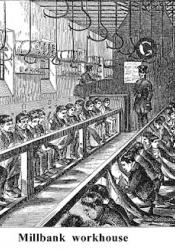Poor Law Amendment Act & Workhouses
In 1834, the poor relief system was costing more and more to the middle and upper classes, due to the perception that people were abusing it. For this reason, the authorities established the Poor Law Amendment Act, also known as the New Poor Law, as a way to have a new approach to deal with poverty. The main purpose of this law was to discourage as much as possible the provision of relief for those who refused to enter a workhouse, where they could take part in labor that would cover their cost of living, while providing a roof over their heads and meals. At first it was actually welcomed by people, who were convinced that it would take care of some of these issues:
This system went on for a long time, and even way past the Victorian Era, and was officially repealed only in 1948 with the National Assistance Act.
Sources:
https://www.nationalarchives.gov.uk/education/resources/1834-poor-law/
https://en.wikipedia.org/wiki/Poor_Law_Amendment_Act_1834
https://navigator.health.org.uk/theme/workhouses-and-poor-law-amendment-act-1834
https://www.historic-uk.com/HistoryUK/HistoryofBritain/Victorian-Workhouse/
http://www.primaryhomeworkhelp.co.uk/victorians/workhouses.html
https://en.wikipedia.org/wiki/Workhouse

